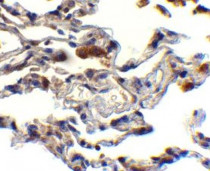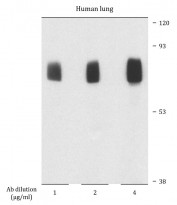ARG41333
anti-cIAP1 + cIAP2 antibody
anti-cIAP1 + cIAP2 antibody for IHC-Formalin-fixed paraffin-embedded sections,Western blot and Human,Mouse
Overview
| Product Description | Rabbit Polyclonal antibody recognizes cIAP1 + cIAP2 |
|---|---|
| Tested Reactivity | Hu, Ms |
| Tested Application | IHC-P, WB |
| Specificity | This antibody detects both cIAP1 and cIAP2. |
| Host | Rabbit |
| Clonality | Polyclonal |
| Isotype | IgG |
| Target Name | cIAP1 + cIAP2 |
| Antigen Species | Human |
| Immunogen | A 14 amino acids synthetic peptide within aa. 540-590 of Human cIAP1. |
| Conjugation | Un-conjugated |
| Alternate Names | cIAP1: MIHB; Baculoviral IAP repeat-containing protein 2; hIAP-2; API1; EC 6.3.2.-; RNF48; Hiap-2; Inhibitor of apoptosis protein 2; cIAP1; IAP-2; RING finger protein 48; C-IAP1; TNFR2-TRAF-signaling complex protein 2; c-IAP1; hIAP2; IAP homolog B; HIAP2 cIAP2: MIHC; EC 6.3.2.-; hIAP1; API2; HIAP1; Baculoviral IAP repeat-containing protein 3; Inhibitor of apoptosis protein 1; hIAP-1; IAP homolog C; CIAP2; RNF49; C-IAP2; IAP-1; RING finger protein 49; HAIP1; c-IAP2; TNFR2-TRAF-signaling complex protein 1; Apoptosis inhibitor 2; MALT2; AIP1 |
Application Instructions
| Application Suggestion |
|
||||||
|---|---|---|---|---|---|---|---|
| Application Note | * The dilutions indicate recommended starting dilutions and the optimal dilutions or concentrations should be determined by the scientist. | ||||||
| Positive Control | Human lung | ||||||
| Observed Size | ~ 70 kDa |
Properties
| Form | Liquid |
|---|---|
| Purification | Affinity purification with immunogen. |
| Buffer | PBS and 0.02% Sodium azide. |
| Preservative | 0.02% Sodium azide |
| Concentration | 1 mg/ml |
| Storage Instruction | For continuous use, store undiluted antibody at 2-8°C for up to a week. For long-term storage, aliquot and store at -20°C or below. Storage in frost free freezers is not recommended. Avoid repeated freeze/thaw cycles. Suggest spin the vial prior to opening. The antibody solution should be gently mixed before use. |
| Note | For laboratory research only, not for drug, diagnostic or other use. |
Bioinformation
| Gene Symbol | BIRC2; BIRC3 |
|---|---|
| Gene Full Name | baculoviral IAP repeat containing 2; baculoviral IAP repeat containing 3 |
| Background | cIAP1: The protein encoded by this gene is a member of a family of proteins that inhibits apoptosis by binding to tumor necrosis factor receptor-associated factors TRAF1 and TRAF2, probably by interfering with activation of ICE-like proteases. This encoded protein inhibits apoptosis induced by serum deprivation and menadione, a potent inducer of free radicals. Alternatively spliced transcript variants encoding different isoforms have been found for this gene. [provided by RefSeq, Jan 2012] cIAP2: This gene encodes a member of the IAP family of proteins that inhibit apoptosis by binding to tumor necrosis factor receptor-associated factors TRAF1 and TRAF2, probably by interfering with activation of ICE-like proteases. The encoded protein inhibits apoptosis induced by serum deprivation but does not affect apoptosis resulting from exposure to menadione, a potent inducer of free radicals. It contains 3 baculovirus IAP repeats and a ring finger domain. Transcript variants encoding the same isoform have been identified. [provided by RefSeq, Aug 2011] |
| Function | cIAP1: Multi-functional protein which regulates not only caspases and apoptosis, but also modulates inflammatory signaling and immunity, mitogenic kinase signaling, and cell proliferation, as well as cell invasion and metastasis. Acts as an E3 ubiquitin-protein ligase regulating NF-kappa-B signaling and regulates both canonical and non-canonical NF-kappa-B signaling by acting in opposite directions: acts as a positive regulator of the canonical pathway and suppresses constitutive activation of non-canonical NF-kappa-B signaling. The target proteins for its E3 ubiquitin-protein ligase activity include: RIPK1, RIPK2, RIPK3, RIPK4, CASP3, CASP7, CASP8, TRAF2, DIABLO/SMAC, MAP3K14/NIK, MAP3K5/ASK1, IKBKG/NEMO, IKBKE and MXD1/MAD1. Can also function as an E3 ubiquitin-protein ligase of the NEDD8 conjugation pathway, targeting effector caspases for neddylation and inactivation. Acts as an important regulator of innate immune signaling via regulation of Toll-like receptors (TLRs), Nodlike receptors (NLRs) and RIG-I like receptors (RLRs), collectively referred to as pattern recognition receptors (PRRs). Protects cells from spontaneous formation of the ripoptosome, a large multi-protein complex that has the capability to kill cancer cells in a caspase-dependent and caspase-independent manner. Suppresses ripoptosome formation by ubiquitinating RIPK1 and CASP8. Can stimulate the transcriptional activity of E2F1. Plays a role in the modulation of the cell cycle. [UniProt] cIAP2: Multi-functional protein which regulates not only caspases and apoptosis, but also modulates inflammatory signaling and immunity, mitogenic kinase signaling and cell proliferation, as well as cell invasion and metastasis. Acts as an E3 ubiquitin-protein ligase regulating NF-kappa-B signaling and regulates both canonical and non-canonical NF-kappa-B signaling by acting in opposite directions: acts as a positive regulator of the canonical pathway and suppresses constitutive activation of non-canonical NF-kappa-B signaling. The target proteins for its E3 ubiquitin-protein ligase activity include: RIPK1, RIPK2, RIPK3, RIPK4, CASP3, CASP7, CASP8, IKBKE, TRAF1, and BCL10. Acts as an important regulator of innate immune signaling via regulation of Toll-like receptors (TLRs), Nodlike receptors (NLRs) and RIG-I like receptors (RLRs), collectively referred to as pattern recognition receptors (PRRs). Protects cells from spontaneous formation of the ripoptosome, a large multi-protein complex that has the capability to kill cancer cells in a caspase-dependent and caspase-independent manner. Suppresses ripoptosome formation by ubiquitinating RIPK1 and CASP8. [UniProt] |
| Cellular Localization | cIAP1: Cytoplasm. Nucleus. Note=Agents that induce either the extrinsic or intrinsic apoptotic pathways promote its redistribution from the nuclear compartment to the cytoplasmic compartment. Associated with the midbody in telophase cells, and found diffusely in the nucleus of interphase cells. [UniProt] cIAP2: Cytoplasm. Nucleus. [UniProt] |
| Calculated MW | cIAP1: 70 kDa cIAP2: 68 kDa |
| PTM | cIAP1 and cIAP2: Auto-ubiquitinated and degraded by the proteasome in apoptotic cells. [UniProt] |
Images (3) Click the Picture to Zoom In
-
ARG41333 anti-cIAP1 + cIAP2 antibody IHC-P image
Immunohistochemistry: Paraffin-embedded Human lung tissue stained with ARG41333 anti-cIAP1 + cIAP2 antibody at 10 µg/ml dilution.
-
ARG41333 anti-cIAP1 + cIAP2 antibody WB image
Western blot: Human lung lysate stained with ARG41333 anti-cIAP1 + cIAP2 antibody at 1, 2 and 4 µg/ml dilution.
-
ARG41333 anti-cIAP1 + cIAP2 antibody IHC-P image
Immunohistochemistry: Paraffin-embedded Human lung tissue stained with ARG41333 anti-cIAP1 + cIAP2 antibody at 20 µg/ml dilution.








